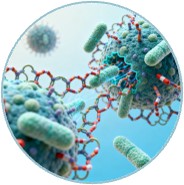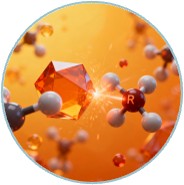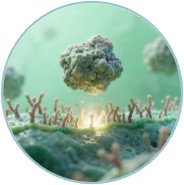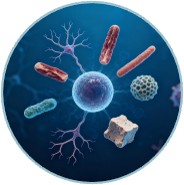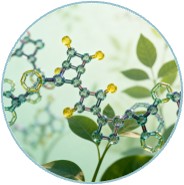Wound healing is a multifaceted biological process that is essential for restoring the skin's barrier function and preventing infections. However, this process can be disrupted by various diseases, leading to chronic wounds that pose a significant medical challenge. Chronic wounds not only cause prolonged suffering for patients but also place a heavy burden on healthcare systems. Over the past few decades, significant advancements in biomaterials and medical devices have revolutionized the field of wound care. This article explores the latest developments in wound healing technologies, focusing on the innovative use of biomaterials, bioactive molecules, and smart medical devices.
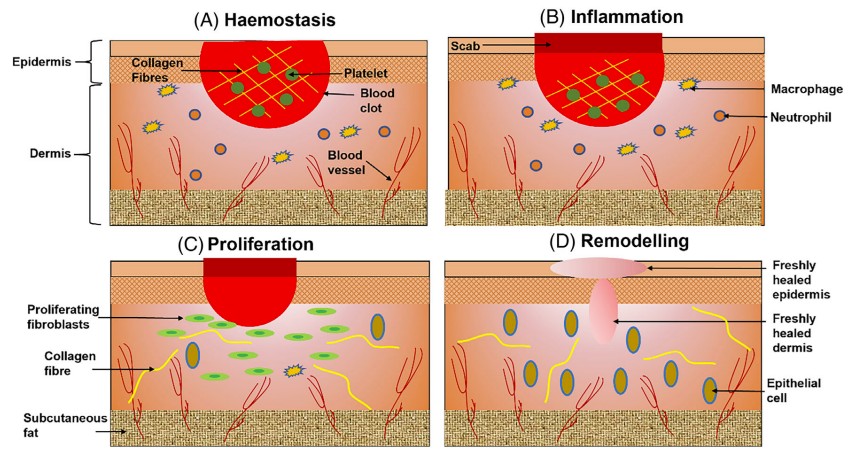 Fig.1 Schematic representation of the cutaneous wound healing. (A) Hemostasis. A wound causes blood clot formation. (B) Inflammation. Recruitment of macrophages and neutrophils. (C) Proliferation. Fibroblast proliferation induces epithelial cell generation. (D) Remodeling. (Deng X., et al., 2022)
Fig.1 Schematic representation of the cutaneous wound healing. (A) Hemostasis. A wound causes blood clot formation. (B) Inflammation. Recruitment of macrophages and neutrophils. (C) Proliferation. Fibroblast proliferation induces epithelial cell generation. (D) Remodeling. (Deng X., et al., 2022)
Understanding the Wound Healing Process
The wound healing process is a dynamic and highly coordinated sequence of events that can be divided into four overlapping phases: hemostasis, inflammation, proliferation, and remodeling. During the hemostasis phase, the body forms a blood clot to stop bleeding. The inflammation phase involves the recruitment of immune cells to clean the wound and prevent infection. Proliferation is marked by the growth of new tissue, while remodeling involves the maturation and strengthening of the newly formed tissue. Any disruption in these phases can lead to chronic wounds, which are characterized by prolonged inflammation, poor blood supply, and bacterial infections.
Biomaterials in Wound Healing
Biomaterials are materials that interact with biological systems and are used to replace or augment tissues. They play a crucial role in wound healing by providing a scaffold for cell growth, delivering bioactive molecules, and promoting tissue regeneration. There are two main types of biomaterials: natural and synthetic.
- Natural Polymers
Natural polymers are derived from biological sources and are often biodegradable and biocompatible. They mimic the extracellular matrix (ECM) of the skin, providing an ideal environment for wound healing.
- Chitosan
Chitosan is a positively charged polymer derived from chitin. It has antimicrobial properties and can enhance drug delivery. Chitosan-based dressings have shown antibacterial properties and can improve wound healing. For example, chitosan/alginate hydrogels loaded with different concentrations of hesperidin have demonstrated better wound closure rates than traditional gauze-treated wounds.
- Keratin
Keratin is a structural protein found in hair, nails, and feathers. It is known for its biocompatibility and structural support. Keratin-based materials are used in films, hydrogels, and scaffolds to facilitate wound healing. Keratin and hyaluronic acid-based PCL/PEO fibers produced via emulsion and coaxial electrospinning techniques have shown improved cell viability and potential for wound dressing applications.
- Collagen
Collagen is the main structural protein in the skin and provides tensile strength. It is used in wound healing biomedical devices due to its ability to stimulate granulation tissue formation and activate angiogenesis. Collagen/chitosan gels incorporated with cell-penetrating peptides (CPP) have shown good wound healing capacity and the ability to retard bacterial proliferation.
- Hyaluronic Acid
Hyaluronic acid is a key component of the ECM and has a high capacity to retain water, which can prevent the wound from drying out and promote healing. Hyaluronic acid-based hydrogels are widely used in wound management. For example, hyaluronic acid/polygalacturonic acid nanofibrous mats embedded with silver nanoparticles have shown efficient wound healing in in vivo studies.
- Alginate
Alginate is a polysaccharide extracted from brown algae. It forms gels that absorb wound exudate and control bacterial growth. Alginate-based hydrogels and nanofibers are widely used in wound dressings. For example, alginate/PVA hydrogels incorporated with PCL microspheres have shown potential for achieving cell-induced tissue regeneration and burn wound healing.
- Silk Fibroin
Silk fibroin is derived from silkworm cocoons and is known for its biocompatibility and mechanical properties. It is used in hydrogels, films, and scaffolds to promote wound healing. Silk fibroin-based dressings have shown high biocompatibility and rapid wound closure rates in animal studies.
- Synthetic Polymers
Synthetic polymers are engineered materials designed to mimic the properties of natural polymers. They offer advantages such as tunable degradation rates and mechanical strength.
- Polyvinyl Alcohol (PVA)
PVA is a biocompatible polymer that can be crosslinked to form stable hydrogels and nanofibers. PVA-based dressings maintain a moist environment and promote healing. For example, PVA/chitosan/starch nanofibrous mats have shown high cell viability and antibacterial properties.
- Polyethylene Glycol (PEG)
PEG is a water-soluble polymer that can be combined with other materials to improve their properties. PEG-based hydrogels and dressings have shown anti-inflammatory and antimicrobial effects. For example, PEG/chitosan hydrogels loaded with silver nanoparticles have demonstrated accelerated wound healing in diabetic patients.
- Polycaprolactone (PCL)
PCL is a biodegradable polymer with good mechanical properties. It is used in electrospun nanofibers and scaffolds for wound healing. For example, PCL/chitosan/curcumin nanofibers have shown antibacterial, antioxidant, and cell proliferation efficiencies.
- Polylactic Acid (PLA)
PLA is a biocompatible and biodegradable polymer used in tissue engineering and suture production. It can be combined with other materials to improve its properties. For example, PLA/PCL nanofibers loaded with herbal extracts have shown effective antibacterial properties.
- Poly(lactic-co-glycolic acid) (PLGA)
PLGA is a copolymer that can be tailored to have specific degradation rates. It is used in scaffolds and drug delivery systems for wound healing. For example, PLGA/gelatin scaffolds have shown high cell proliferation and lack of inflammatory response.
Bioactive Molecules and Drugs
Bioactive molecules and drugs can be incorporated into biomaterials to enhance wound healing. These include:
Antibiotics
Antibiotics are used to prevent and treat bacterial infections. For example, PVA/chitosan nanofibers loaded with antibiotics have shown effective antibacterial properties and accelerated wound healing.
Antioxidants
Antioxidants reduce oxidative stress and promote healing. For example, curcumin-loaded PCL/gelatin nanofibers have shown sustained release of curcumin and significant wound closure in in vivo studies.
Growth Factors
Growth factors stimulate cell proliferation and tissue regeneration. For example, collagen/chitosan gels loaded with platelet-derived growth factor (PDGF) have shown improved wound healing capacity.
Stem Cells
Stem cells enhance tissue repair and regeneration. For example, adipose-derived stem cells (ADSCs) have been shown to accelerate diabetic wound healing in a similar fashion to bone marrow-derived cells.
Natural Compounds
Natural compounds such as honey, aloe vera, and curcumin have antimicrobial, anti-inflammatory, and antioxidant properties. For example, Manuka honey has been shown to reduce inflammation and promote fibroblast migration, enhancing wound healing.
Medical Devices for Wound Management
Advanced medical devices have been developed to facilitate wound healing and manage chronic wounds. These include:
Wound Dressings
Wound dressings are designed to maintain a moist environment, prevent infection, and promote healing. They come in various forms, including hydrogels, nanofibers, and biological dressings. For example, hyaluronic acid-based hydrogels have shown efficient wound healing in in vivo studies.
Wearable Wound Monitors
These devices provide real-time monitoring of wound healing by detecting changes in temperature, pH, and other biomarkers. For example, a pH-sensitive dressing changes color to indicate changes in wound pH, providing early detection of infection.
Negative Pressure Wound Therapy (NPWT)
NPWT uses a vacuum to remove excess fluid and promote healing. It can be combined with instillation of solutions to enhance its effects. For example, NPWT with instillation has been shown to accelerate tissue granulation and reduce bacterial load in chronic wounds.
Surgical Sutures
Surgical sutures can be engineered to release bioactive molecules and drugs, reducing the risk of infection and promoting wound healing. For example, PCL/collagen sutures loaded with basic fibroblast growth factor (bFGF) have shown sustained release and improved wound healing.
Case Studies and Applications
- Hydrogels
Hydrogels are swellable dressings that provide a moist environment for wound healing. They can be loaded with bioactive molecules to enhance their effects. For example, a hydrogel loaded with vascular endothelial growth factor (VEGF) has been shown to accelerate wound healing in a full-thickness skin model.
- Nanofiber Scaffolds
Nanofiber scaffolds mimic the ECM and provide a supportive environment for cell growth and tissue regeneration. They can be loaded with drugs and bioactive molecules to promote healing. For example, a PCL/collagen scaffold loaded with bioactive glass nanoparticles has shown improved wound healing in diabetic rats.
- Smart Wound Dressings
Smart wound dressings incorporate sensors to monitor wound healing in real-time. For example, a pH-sensitive dressing changes color to indicate changes in wound pH, providing early detection of infection.
- NPWT Devices
NPWT devices use a vacuum to remove excess fluid and promote healing. They can be combined with the instillation of solutions to enhance their effects. For example, NPWT with instillation has been shown to accelerate tissue granulation and reduce bacterial load in chronic wounds.
- Surgical Sutures
Surgical sutures can be engineered to release bioactive molecules and drugs, reducing the risk of infection and promoting wound healing. For example, PCL/collagen sutures loaded with basic fibroblast growth factor (bFGF) have shown sustained release and improved wound healing.
Conclusion
The field of wound healing has seen significant advancements in recent years, thanks to the development of innovative biomaterials, bioactive molecules, and smart medical devices. These technologies offer new hope for patients with chronic wounds and hold the potential to revolutionize wound care. Future research should focus on developing personalized wound management strategies and exploring the potential of natural bioactive molecules in wound healing.
If you have related needs, please feel free to contact us for more information or product support.
Reference
- Deng, Xiaoxuan, Maree Gould, and M. Azam Ali. "A review of current advancements for wound healing: Biomaterial applications and medical devices." Journal of Biomedical Materials Research Part B: Applied Biomaterials 110.11 (2022): 2542-2573.
These products and services are for research use only and cannot be used for any clinical purposes!



 Fig.1 Schematic representation of the cutaneous wound healing. (A) Hemostasis. A wound causes blood clot formation. (B) Inflammation. Recruitment of macrophages and neutrophils. (C) Proliferation. Fibroblast proliferation induces epithelial cell generation. (D) Remodeling. (Deng X., et al., 2022)
Fig.1 Schematic representation of the cutaneous wound healing. (A) Hemostasis. A wound causes blood clot formation. (B) Inflammation. Recruitment of macrophages and neutrophils. (C) Proliferation. Fibroblast proliferation induces epithelial cell generation. (D) Remodeling. (Deng X., et al., 2022)